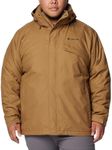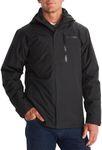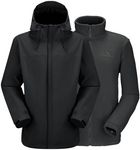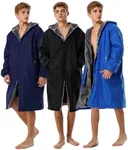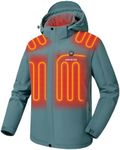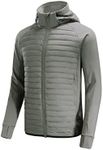Buying Guide for the Best Mens 3 In 1 Jackets
Choosing the right men's 3-in-1 jacket can be a bit overwhelming, but with the right approach, you can find the perfect fit for your needs. A 3-in-1 jacket typically consists of an outer shell and an inner layer that can be worn separately or together, providing versatility for different weather conditions. To make an informed decision, consider the following key specifications and how they align with your lifestyle and activities.MaterialThe material of a 3-in-1 jacket is crucial as it determines the jacket's durability, breathability, and weather resistance. Common materials include polyester, nylon, and Gore-Tex. Polyester and nylon are lightweight and durable, making them suitable for everyday use and mild weather. Gore-Tex is a high-performance material that offers excellent waterproofing and breathability, ideal for extreme weather conditions and outdoor activities. Choose a material based on the typical weather you encounter and the activities you plan to do.
WaterproofingWaterproofing is essential for keeping you dry in wet conditions. Jackets are often rated by their waterproofing capabilities, measured in millimeters (mm). A rating of 5,000mm to 10,000mm is suitable for light to moderate rain, while 10,000mm to 20,000mm is better for heavy rain and snow. For extreme conditions, look for ratings above 20,000mm. Consider your local climate and how often you'll be exposed to rain or snow when choosing the right level of waterproofing.
InsulationInsulation in a 3-in-1 jacket provides warmth and can be made from down or synthetic materials. Down insulation is lightweight and offers excellent warmth, making it ideal for very cold conditions. However, it can lose its insulating properties when wet. Synthetic insulation, on the other hand, retains warmth even when damp and is generally more affordable. Choose down for extremely cold and dry environments, and synthetic for wet or variable conditions.
Fit and SizeThe fit and size of a jacket affect comfort and mobility. Jackets come in various fits, such as slim, regular, and relaxed. A slim fit is more form-fitting and stylish, suitable for casual wear. A regular fit offers a balance between comfort and mobility, ideal for general outdoor activities. A relaxed fit provides extra room for layering and is great for intense activities or colder climates. Consider your body shape, layering needs, and the primary use of the jacket when selecting the fit and size.
VentilationVentilation features, such as pit zips or mesh-lined pockets, help regulate body temperature by allowing excess heat and moisture to escape. This is particularly important during high-intensity activities or in fluctuating weather conditions. If you plan to use the jacket for activities like hiking, skiing, or snowboarding, look for jackets with good ventilation options to stay comfortable and dry.
HoodA hood provides additional protection against the elements. Some jackets come with detachable or adjustable hoods, offering flexibility based on weather conditions. A well-designed hood should fit snugly around your head, ideally with a brim to keep rain or snow off your face. Consider how often you'll need head protection and whether you prefer a fixed or removable hood.
PocketsPockets are essential for carrying essentials like keys, phone, and wallet. The number, size, and placement of pockets can vary. Look for jackets with secure, easily accessible pockets that suit your needs. For outdoor activities, consider jackets with additional pockets for gear like maps, snacks, or gloves. Think about what you typically carry and choose a jacket with a pocket configuration that works for you.



